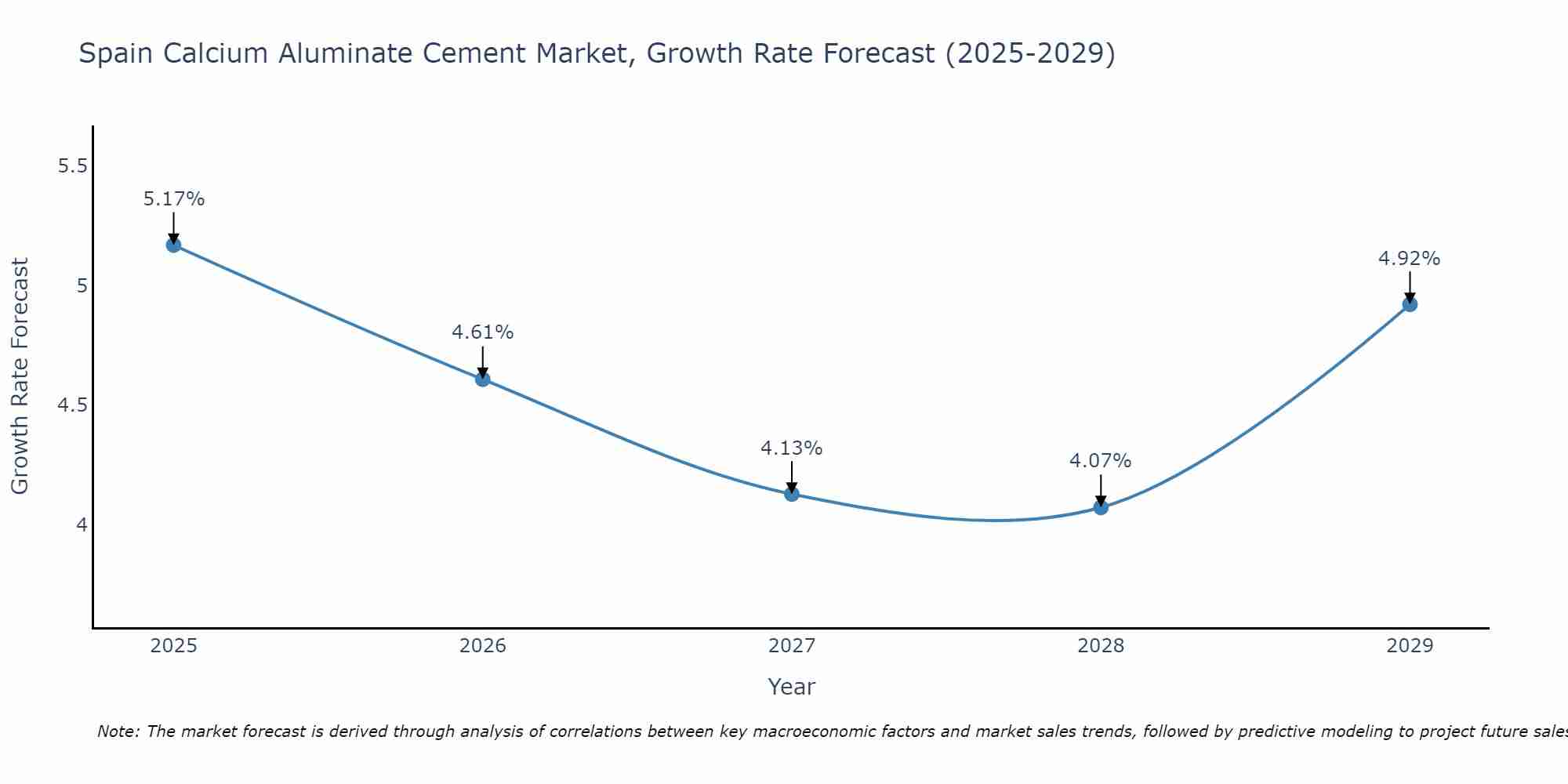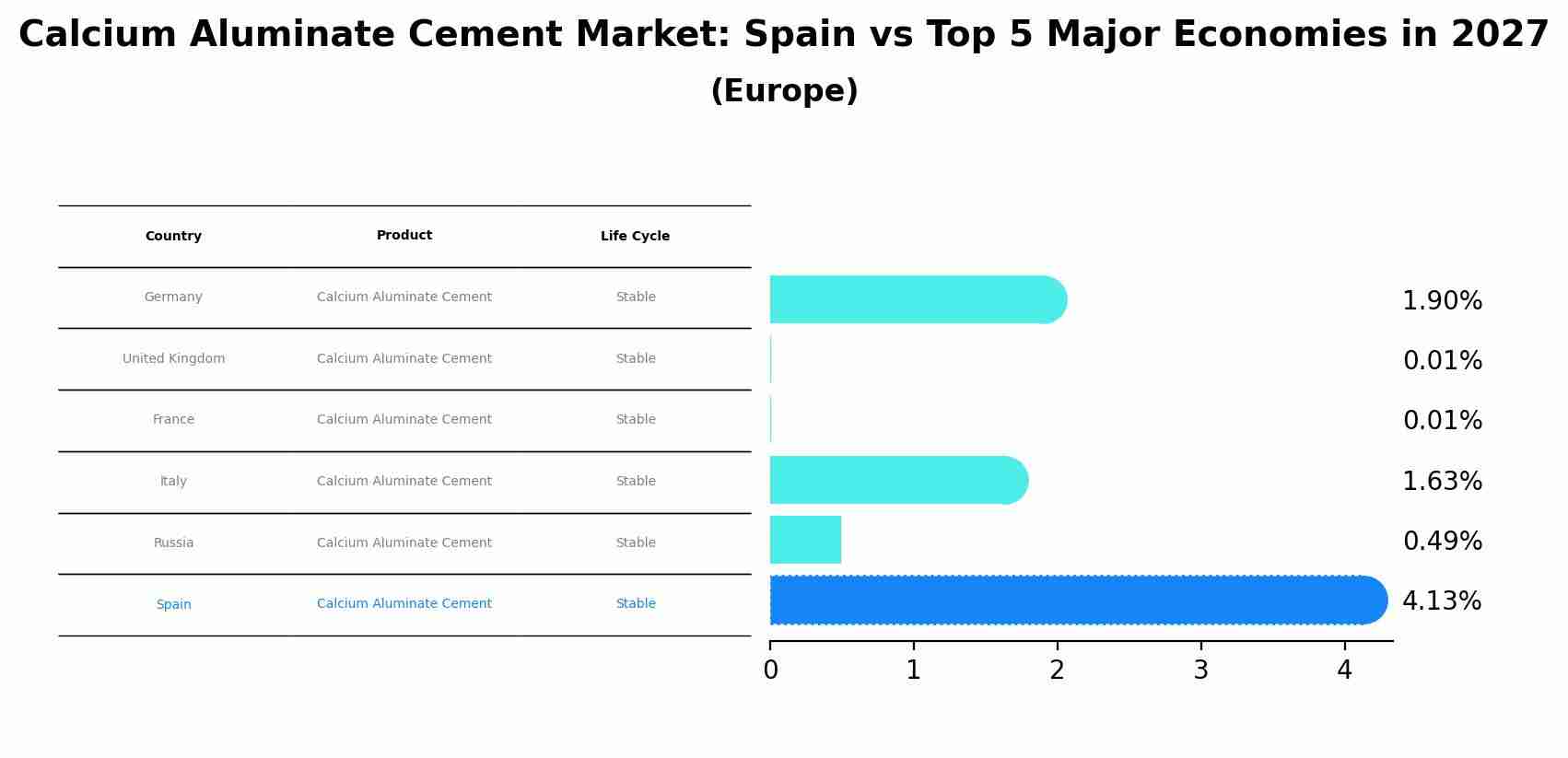Spain Calcium Aluminate Cement Market Outlook | Analysis, Revenue, Forecast, COVID-19 IMPACT, Share, Trends, Value, Size, Growth, Industry & Companies
| Product Code: ETC316694 | Publication Date: Aug 2022 | Updated Date: Jun 2025 | Product Type: Market Research Report | |
| Publisher: 6Wresearch | Author: Dhaval Chaurasia | No. of Pages: 75 | No. of Figures: 35 | No. of Tables: 20 |
Spain Calcium Aluminate Cement Market Size Growth Rate
The Spain Calcium Aluminate Cement Market is projected to witness mixed growth rate patterns during 2025 to 2029. Starting high at 5.17% in 2025, the market steadily declines to 4.92% by 2029.

Calcium Aluminate Cement Market: Spain vs Top 5 Major Economies in 2027 (Europe)
Spain's Calcium Aluminate Cement market is anticipated to experience a stable growth rate of 4.13% by 2027, reflecting trends observed in the largest economy Germany, followed by United Kingdom, France, Italy and Russia.

Spain Calcium Aluminate Cement Market Overview
The Spain Calcium Aluminate Cement Market is characterized by steady growth driven by increasing demand in various applications such as construction, refractories, and industrial processes. The market is largely dominated by key players like Kerneos and Almatis, who focus on product innovation and expansion of their distribution networks. The construction sector is a significant contributor to the market growth, with calcium aluminate cement being preferred for its high performance in specialized applications like rapid setting, high-temperature resistance, and sulfate resistance. The market is also influenced by factors like government regulations promoting sustainable construction practices and the increasing adoption of advanced materials in infrastructure projects. Overall, the Spain Calcium Aluminate Cement Market is expected to witness continued growth, supported by ongoing investments in construction and infrastructure development.
Spain Calcium Aluminate Cement Market Trends
The Spain Calcium Aluminate Cement market is experiencing growth driven by increasing demand from construction and infrastructure projects in the country. Calcium Aluminate Cement is gaining popularity due to its superior performance characteristics such as high early strength development, fast setting time, and resistance to harsh environmental conditions. The market is also seeing a rise in research and development activities focused on improving the properties of Calcium Aluminate Cement for specific applications. Additionally, there is a growing emphasis on sustainable construction practices, leading to the adoption of Calcium Aluminate Cement as a viable eco-friendly alternative. Overall, the Spain Calcium Aluminate Cement market is expected to continue expanding in the coming years, driven by the construction sector`s increasing need for high-performance building materials.
Spain Calcium Aluminate Cement Market Challenges
In the Spain Calcium Aluminate Cement Market, some challenges faced include increasing competition from alternative cement products like Portland cement, limited awareness and understanding of the benefits of calcium aluminate cement among construction professionals, and fluctuating raw material costs. Additionally, the relatively higher cost of calcium aluminate cement compared to traditional cement types can be a barrier for widespread adoption in the construction industry. Addressing these challenges will require targeted marketing efforts to educate stakeholders about the superior properties of calcium aluminate cement, strategic pricing strategies to remain competitive, and effective supply chain management to mitigate the impact of raw material cost fluctuations.
Spain Calcium Aluminate Cement Market Investment Opportunities
The Spain Calcium Aluminate Cement Market presents promising investment opportunities due to the increasing construction activities and infrastructure development in the region. With a growing emphasis on sustainable building materials, calcium aluminate cement is gaining traction for its high-performance characteristics, such as rapid setting and strength development. Investing in companies that manufacture or distribute calcium aluminate cement in Spain could be lucrative, especially with the rising demand for advanced construction materials. Additionally, there is potential for research and development in this sector to innovate and enhance the properties of calcium aluminate cement, catering to evolving market requirements and regulations. Overall, the Spain Calcium Aluminate Cement Market offers opportunities for investors to capitalize on the growing construction industry and the shift towards more sustainable building practices.
Spain Calcium Aluminate Cement Market Government Policy
In Spain, the government has implemented several policies to regulate the Calcium Aluminate Cement Market. These policies include environmental regulations aimed at reducing carbon emissions and promoting sustainable production practices. Additionally, there are quality standards and certifications in place to ensure that Calcium Aluminate Cement products meet certain specifications and performance requirements. The government also provides support for research and development initiatives in the cement industry to foster innovation and technological advancement. Overall, the regulatory framework in Spain for the Calcium Aluminate Cement Market focuses on promoting environmental sustainability, product quality, and industry competitiveness through a combination of regulations, standards, and government support programs.
Spain Calcium Aluminate Cement Market Future Outlook
The Spain Calcium Aluminate Cement market is expected to witness steady growth in the coming years due to increasing infrastructure development projects, particularly in the construction industry. With the rising focus on sustainable and high-performance building materials, calcium aluminate cement is gaining popularity for its superior properties, such as high strength, rapid setting, and resistance to harsh environments. Additionally, the growing demand for calcium aluminate cement in various applications, including refractories, sewage systems, and industrial flooring, is anticipated to drive market expansion. Factors such as stringent regulations promoting eco-friendly construction materials and the increasing adoption of specialty cements for niche applications are likely to further boost the market growth in Spain. Overall, the Spain Calcium Aluminate Cement market is poised for a positive outlook in the foreseeable future.
Key Highlights of the Report:
- Spain Calcium Aluminate Cement Market Outlook
- Market Size of Spain Calcium Aluminate Cement Market, 2021
- Forecast of Spain Calcium Aluminate Cement Market, 2031
- Historical Data and Forecast of Spain Calcium Aluminate Cement Revenues & Volume for the Period 2018 - 2031
- Spain Calcium Aluminate Cement Market Trend Evolution
- Spain Calcium Aluminate Cement Market Drivers and Challenges
- Spain Calcium Aluminate Cement Price Trends
- Spain Calcium Aluminate Cement Porter's Five Forces
- Spain Calcium Aluminate Cement Industry Life Cycle
- Historical Data and Forecast of Spain Calcium Aluminate Cement Market Revenues & Volume By Product for the Period 2018 - 2031
- Historical Data and Forecast of Spain Calcium Aluminate Cement Market Revenues & Volume By CAC 40 for the Period 2018 - 2031
- Historical Data and Forecast of Spain Calcium Aluminate Cement Market Revenues & Volume By CAC 50 for the Period 2018 - 2031
- Historical Data and Forecast of Spain Calcium Aluminate Cement Market Revenues & Volume By CAC 60 for the Period 2018 - 2031
- Historical Data and Forecast of Spain Calcium Aluminate Cement Market Revenues & Volume By CAC 70-80 for the Period 2018 - 2031
- Spain Calcium Aluminate Cement Import Export Trade Statistics
- Market Opportunity Assessment By Product
- Spain Calcium Aluminate Cement Top Companies Market Share
- Spain Calcium Aluminate Cement Competitive Benchmarking By Technical and Operational Parameters
- Spain Calcium Aluminate Cement Company Profiles
- Spain Calcium Aluminate Cement Key Strategic Recommendations
Frequently Asked Questions About the Market Study (FAQs):
1 Executive Summary |
2 Introduction |
2.1 Key Highlights of the Report |
2.2 Report Description |
2.3 Market Scope & Segmentation |
2.4 Research Methodology |
2.5 Assumptions |
3 Spain Calcium Aluminate Cement Market Overview |
3.1 Spain Country Macro Economic Indicators |
3.2 Spain Calcium Aluminate Cement Market Revenues & Volume, 2021 & 2031F |
3.3 Spain Calcium Aluminate Cement Market - Industry Life Cycle |
3.4 Spain Calcium Aluminate Cement Market - Porter's Five Forces |
3.5 Spain Calcium Aluminate Cement Market Revenues & Volume Share, By Product, 2021 & 2031F |
4 Spain Calcium Aluminate Cement Market Dynamics |
4.1 Impact Analysis |
4.2 Market Drivers |
4.3 Market Restraints |
5 Spain Calcium Aluminate Cement Market Trends |
6 Spain Calcium Aluminate Cement Market, By Types |
6.1 Spain Calcium Aluminate Cement Market, By Product |
6.1.1 Overview and Analysis |
6.1.2 Spain Calcium Aluminate Cement Market Revenues & Volume, By Product, 2021-2031F |
6.1.3 Spain Calcium Aluminate Cement Market Revenues & Volume, By CAC 40, 2021-2031F |
6.1.4 Spain Calcium Aluminate Cement Market Revenues & Volume, By CAC 50, 2021-2031F |
6.1.5 Spain Calcium Aluminate Cement Market Revenues & Volume, By CAC 60, 2021-2031F |
6.1.6 Spain Calcium Aluminate Cement Market Revenues & Volume, By CAC 70-80, 2021-2031F |
7 Spain Calcium Aluminate Cement Market Import-Export Trade Statistics |
7.1 Spain Calcium Aluminate Cement Market Export to Major Countries |
7.2 Spain Calcium Aluminate Cement Market Imports from Major Countries |
8 Spain Calcium Aluminate Cement Market Key Performance Indicators |
9 Spain Calcium Aluminate Cement Market - Opportunity Assessment |
9.1 Spain Calcium Aluminate Cement Market Opportunity Assessment, By Product, 2021 & 2031F |
10 Spain Calcium Aluminate Cement Market - Competitive Landscape |
10.1 Spain Calcium Aluminate Cement Market Revenue Share, By Companies, 2021 |
10.2 Spain Calcium Aluminate Cement Market Competitive Benchmarking, By Operating and Technical Parameters |
11 Company Profiles |
12 Recommendations |
13 Disclaimer |
- Single User License$ 1,995
- Department License$ 2,400
- Site License$ 3,120
- Global License$ 3,795
Search
Related Reports
- Portugal Occupational Health & Safety Services Market (2025-2031) | Strategy, Consumer Insights, Analysis, Investment Trends, Opportunities, Growth, Size, Share, Industry, Revenue, Segments, Value, Segmentation, Supply, Forecast, Restraints, Outlook, Competition, Drivers, Trends, Demand, Pricing Analysis, Competitive, Strategic Insights, Companies, Challenges
- Netherlands Occupational Health and Safety Services Market (2025-2031) | Strategy, Consumer Insights, Analysis, Investment Trends, Opportunities, Growth, Size, Share, Industry, Revenue, Segments, Value, Segmentation, Supply, Forecast, Restraints, Outlook, Competition, Drivers, Trends, Demand, Pricing Analysis, Competitive, Strategic Insights, Companies, Challenges
- Belgium and Luxembourg Facility Management Market (2025-2031) | Strategy, Consumer Insights, Analysis, Investment Trends, Opportunities, Growth, Size, Share, Industry, Revenue, Segments, Value, Segmentation, Supply, Forecast, Restraints, Outlook, Competition, Drivers, Trends, Demand, Pricing Analysis, Competitive, Strategic Insights, Companies, Challenges
- Russia Women Intimate Apparel Market (2025-2031) | Strategy, Consumer Insights, Analysis, Investment Trends, Opportunities, Growth, Size, Share, Industry, Revenue, Segments, Value, Segmentation, Supply, Forecast, Restraints, Outlook, Competition, Drivers, Trends, Demand, Pricing Analysis, Competitive, Strategic Insights, Companies, Challenges
- Africa Chocolate Market (2025-2031) | Size, Share, Trends, Growth, Revenue, Analysis, Forecast, industry & Outlook
- Global Hydroxychloroquine And Chloroquine Market (2025-2031) | Industry, Trends, Size, Outlook, Growth, Value, Companies, Revenue, Analysis, Share, Forecast
- Saudi Arabia Plant Maintenance Market (2025-2031) | Industry, Size, Growth, Revenue, Value, Companies, Forecast, Analysis, Share & Trends
- Taiwan Electric Truck Market (2025-2031) | Outlook, Industry, Revenue, Size, Forecast, Growth, Analysis, Share, Companies, Value & Trends
- South Korea Electric Bus Market (2025-2031) | Outlook, Industry, Companies, Analysis, Size, Revenue, Value, Forecast, Trends, Growth & Share
- Africa Low Temperature Powder Coating Market (2025-2031) | Companies, Competition, Size, Challenges, Segmentation, Trends, Competitive, Industry, Supply, Strategy, Investment Trends, Growth, Segments, Restraints, Strategic Insights, Revenue, Share, Forecast, Drivers, Analysis, Pricing Analysis, Demand, Consumer Insights, Value, Opportunities, Outlook
Industry Events and Analyst Meet
Our Clients
Whitepaper
- Middle East & Africa Commercial Security Market Click here to view more.
- Middle East & Africa Fire Safety Systems & Equipment Market Click here to view more.
- GCC Drone Market Click here to view more.
- Middle East Lighting Fixture Market Click here to view more.
- GCC Physical & Perimeter Security Market Click here to view more.
6WResearch In News
- Doha a strategic location for EV manufacturing hub: IPA Qatar
- Demand for luxury TVs surging in the GCC, says Samsung
- Empowering Growth: The Thriving Journey of Bangladesh’s Cable Industry
- Demand for luxury TVs surging in the GCC, says Samsung
- Video call with a traditional healer? Once unthinkable, it’s now common in South Africa
- Intelligent Buildings To Smooth GCC’s Path To Net Zero













